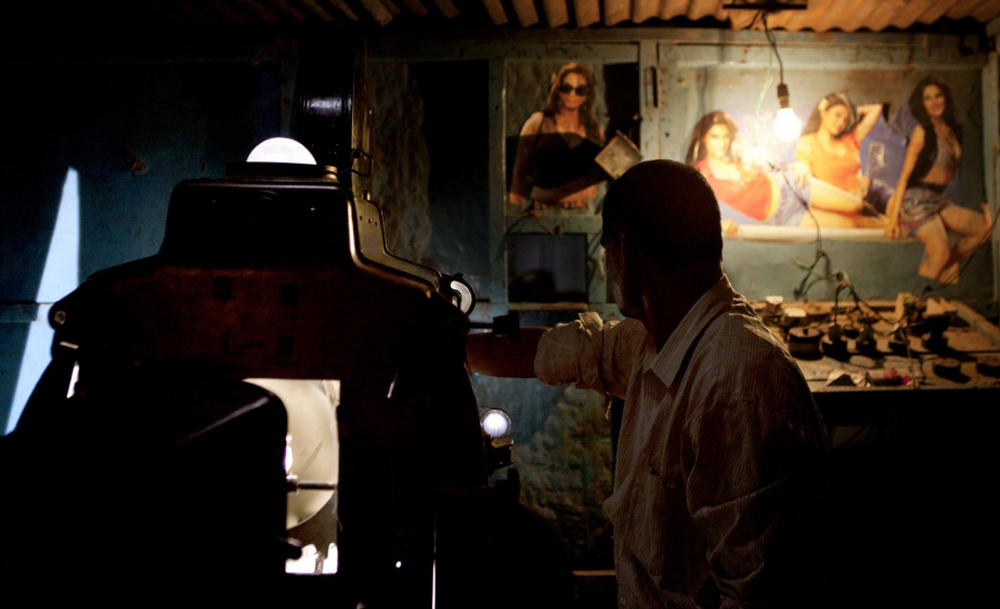Shirley Abraham and Amit Madheshiya both shouldn’t have seen their first movie when they did. Growing up in India, Abraham wasn’t allowed to watch movies as a child, deciding to sneak out of bed into the room where the television was and put a cloth over the screen so as not to wake anyone around her with the light, while Madheshiya recreated “The Great Escape” before ever actually seeing it for himself, tip-toeing out of his grandparents’ house to a wedding nearby where he witnessed the magic of images projected onto the big screen for the first time.
It shouldn’t be surprising that the two became hooked on moviegoing for life, nor that they found each other in college pursuing a similar track of study in film history with a particular interest in how films affect the human psyche. What may be startling, however, is how Abraham and Madheshiya have touched on profound ideas about the medium while making it feel as if it’s been born anew in their first feature together “The Cinema Travellers.” Traversing all across India, the filmmakers follow three men carrying on a proud tradition of the traveling cinemas in the movie mad country, setting up tents in rural villages to bring movies to those who rarely get the chance to see them, creating truly magical experiences under the night sky. In tracking Mohammed, a wily entrepreneur, Bapu, a veteran showman and Prakash, a repairman of projectors, “The Cinema Travellers” offers up the unusual experience of presenting a culture that is rarely seen onscreen while that becomes a two-way mirror, as those we see in the film are entranced with the glimpse they get at a world far removed from their own.
While “The Cinema Travellers” has a certain elegiac quality, owing to the fact that the five years Abraham and Madheshiya spent on the project coincided with the global transition from celluloid projection to digital, presenting new challenges if not the demise of Mohammed, Bapu and Prakash’s way of life, the film never feels like anything less than a celebration of how cinema can move people, not only in how it observes the joy of people young and old watching movies as it travels from big regional fairs to the quiet centers of the desert, but in how it embraces all the tools of the medium to create a truly transporting experience. Both visually resplendent and aurally seductive, the film has been reopening the eyes of even the most jaded of moviegoers as it travels the festival circuit, following a premiere at Cannes earlier this year, and while Abraham and Madheshiya were at the New York Film Festival, they took the time to speak about how “The Cinema Travellers,” which began life as a still photography project, came together as a film.

Amit Madheshiya: Early on, when we were looking [at where] people were watching films in different parts of the country, we traveled the length of the country and met all kinds of people taking films to the people who did not have access to big screens. It was a research project and I was taking photographs, and that’s how we chanced upon these Traveling Cinemas in Maharashtra where the film is set. We knew this system was unlike anything we’ve ever seen in our lives, and it’s been in existence for about seven decades. Very curiously, there wasn’t any mention of these traveling cinemas in [any] history of the country [we read], so it really caught our interest. We invested much more time learning about it and we found some fascinating stories there and the idea it would be better as a film came.
Shirley Abraham: When we were traveling, we also knew that this old, charming system of exhibition is probably looking at a moment of change. We knew there’s going to be other forms of media that will start tiptoeing their way into the system and these people had run this system of exhibition on celluloid technology, taking projectors to these far away places for so long and that is when we thought that this could be a film to tell the story of how is it that this antiquated system that has been turning for 70 years will [face] change and how we as human beings look at change. These showmen will look at their own positions as the only people who brought the movies for so long because eventually the technology that they have will also be accessible by their audiences, and we were trying to see how the different showmen would respond to it.

Shirley Abraham: We had met Mohammed, this quintessential showman, and everything about him is about the here and now. We had a sense that he would be more open to this kind of change. And we were looking for his counterpart and then we met Bapu, who was really looking at his legacy. He was trying to run the cinema for the children of the village and it’s almost like [he considers] this [as a] moral duty that he’s performing, and we felt these were interesting value systems that are contrasting in nature, but worked together to help us build a picture of these traveling cinemas. They both had this contrasting association with time, which was very important for this film — Mohammed is someone who wants to just keep moving forward as quickly as he can while Bapu is somewhat still reflecting on the glory of the past. Prakash then became a very interesting bridge between these two currents as someone who could’ve existed in the past, but he’s also somebody who can look to the future. So we knew that their associations could build up to something really compelling for the film.
Amit Madheshiya: Since we were making a film about the grand narrative of cinema, time became a huge character and time is a very subjective thing. Time doesn’t really exist. It’s a construct of us human beings, so the three characters that we have are looking at time and their time is different from each other. Mohammed, the young exhibitor is somebody who lives in the present and he has to make a living and he will do things so that this day is a good day for him. Bapu is so deeply rooted in his past that he’s nostalgic for it whereas Prakash, when we come to him, he’s this very interesting person somewhere in between – he’s somebody who belongs to the past who really finds great repose in that, but he’s also somebody who can look into the future. He could be someone from 100 years ago or a 1000 years from now.
It’s such a cinematic film – was it a challenge to bring out the cinema in this subject?
Amit Madheshiya: Very early on in our process, we realized that we had this rather beautiful burden of cinema upon us — we were making a film about cinema and it had to speak the language of cinema. It’s not very easy to do that because there are so many crutches you can rely upon to take your narrative ahead, but we really wanted to make a film that is in a way purer to the form of cinematic language. That truly became the impetus for us to look at this film in a a different and unique way. All the choices that we made in the visual language or the narrative arc of the film was geared towards serving this grander narrative of cinema. We were looking at this world that’s at the cusp of change and it’s going to be lost to time and you’re looking at it through the lens of a myth.

Amit Madheshiya: When we talk about Prakash, he’s somebody who’s all alone now, so his past is all that he’s got. He lives alone, almost like an ascetic, in his workshop-like cave and nobody’s coming to him, so we were really struggling to find an image to be able to show how lonely he is physically, but not really in his imagination because that’s how he travels through the landscape and he goes to places he has never been to. He never found time to take up that instrument that he bought many, many years ago, and [when we learned about it, it] really became an embodiment of two things – his loneliness now, which is in the present and his busyness that was in the past and the glory that he speaks about, so that’s how we arrived at that scene. He has built this projector in which he’s invested his entire life [in] and so we merged the sounds of these two because on one hand, there is this musical instrument he never had time to play because he’s [been working on] this beautiful projector for all these years and now they’re running parallel in time. We are at this wonderful spot in which we don’t know which way is he going to go in the next couple minutes of the film, so that’s the point where we bring his two different, parallel lives together.
In general, the machinery comes alive in the way that you film it, imbued with the humanity that clearly your subjects see in it. Was that difficult to convey?
Amit Madheshiya: It was a real struggle for us to be able to achieve that. We had these wonderful machines in our film that were generations old and they were like characters, but these are lifeless objects and how is it that we identify with them? The answer to this came in two ways – one, how the characters in our film react to machines, which is very reverential. They worship these machines that have been handed down for generations and they have been carrying it on their shoulders for almost seven decades now, repairing it and reusing it, so that was one aspect to it.
Then secondly, we went to the Sundance Sound Design and Music Lab and something really struck us one day. I was standing outside and there was this swarm of bees. Frankly, it reminded me of the sound of the projector. We had this wonderful sound designer Pete Horner, who was working with us, and when we told him this idea, he jumped at it and said, “Let’s do a mix of that.” He recorded live bees and mixed it with the sound of the projector machine, so it gave life to this inanimate object. Suddenly, it was much more organic. It was lifelike and although you don’t see any perceptible difference, this is what sound can do — it can make you feel a very different way, and it really helped us bring that life into the machines. That’s why I think you are affected by when the machine is dead and it’s broken down.

Shirley Abraham: The fairs were difficult to navigate, but we spent a lot of time at the fairs to know exactly what we were in for. We knew there were going to be a thousand people and that these people had come to the cinema after one whole year and how much anticipation there is. People can get really restless when the reels are delayed and the show is not moving on time, so they were a little bit difficult, but we embraced them because it just brought to life [to Mohammed’s story]. Mohammed’s world is vibrant and pulsating and he’s setting up the show, so that really worked well for us.
One of the crazy days I remember was when we were filming Mohammed going to buy the digital projector. It seemed like this endless business transaction and we were just following it on instinct, but at the end of the day, the man who was selling Mohammed the digital machine decides to show him around. That is when documentary filmmaking is showering you with the gifts that you’re not smart enough to think that you could construct. They ended up in the cave and all through [the filming of] this, I had wanted to find something that speaks to cinema in the place of human civilization and what does it mean to create, sustain and nourish these cinemas. In the space of that cave, the man who was showing Mohammed around was talking about the instinct of creation and how we now wonder who etched these cave sketches. Back then, they had no machinery, but they had their imaginations, and that is something that is so special to the film. It is something that I really wanted the audiences to carry with them, but I had no idea that we were going to be gifted with it in this form, so it was a crazy day, but one of the most gratifying.
What’s it been like to travel with the film and show it to audiences?
Shirley Abraham: It’s been such a joy. When you’re making the film, you’re so occupied with the prospects of just finishing it, but then comes a moment where you’re sitting with an audience in the space of a darkened cinema and all the audience is in that moment. Everybody has embraced the film in a way that has been really special to us.
Amit Madheshiya: It feels as if this is what cinema began with almost 120 years ago when the Lumiere brothers started traveling with their films, because the idea [then] was to bring the world to the world through cinema. I think we’re still doing the same thing, bringing [India] to the rest of the world and film festivals are a great window for us to look into the far-away world.
“The Cinema Travellers” does not yet have U.S. distribution. It will play once more at the New York Film Festival on October 16th at 3:30 pm at the Bruno Walter Auditorium. A schedule of future cities and dates is here.




